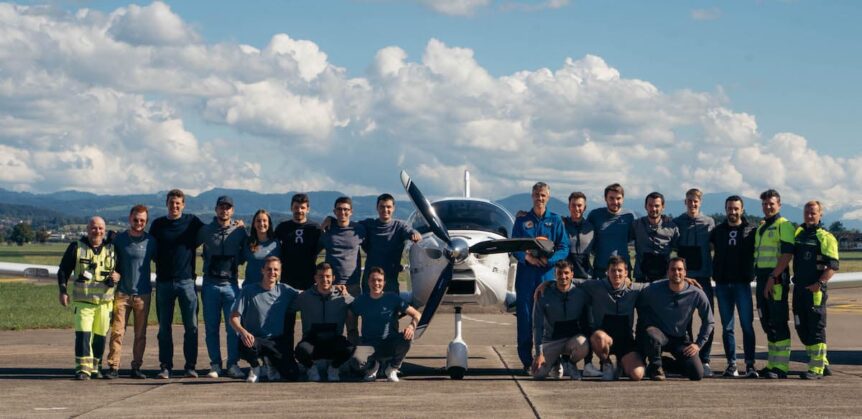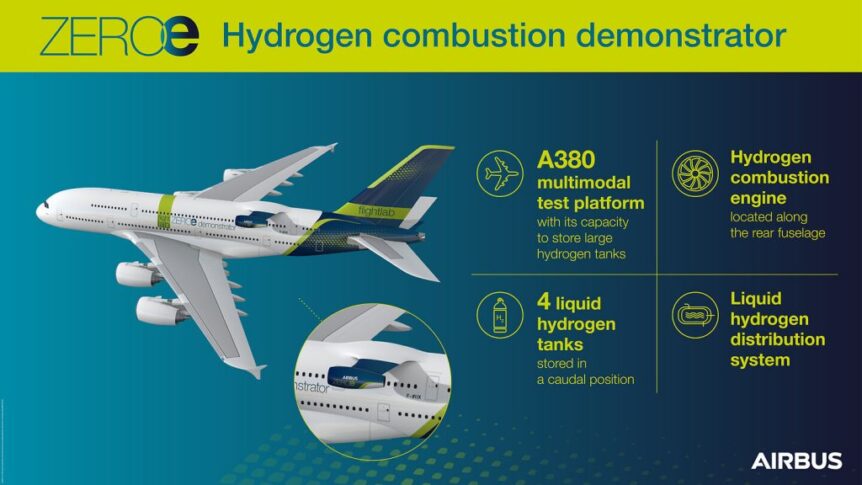Two groups of students, AeroDelft in The Netherlands and ETH Cellsius in Switzerland, are making great progress on some extremely advanced aeronautical projects. Each school’s ultimate goal seems to be flying with liquid hydrogen, and each has a slightly different approach to that goal. AeroDelft: Starting Small AeroDelft, the student-led project at Delft University of Technology, flew a 1/3 scale model that closely resembles e-Genius in July. Its 1,500 Watt (two kilowatt) motor is powered by 40 grams (1.411 ounces) of gaseous hydrogen initially, but will transition to liquid H2 later in the program. 380 grams (13.4 ounces) of the more potent fuel will allow three hours endurance and a range of almost 300 kilometers (186 miles) Since that flight, the team has exhibited at various trade shows and advanced work on its Sling 4 two-seat light aircraft. The 920 kilogram (2,024 pound) maximum takeoff weight aircraft, powered by a 110 kilowatt (147.4 horsepower) motor flies on battery power for …
Airbus and CFM: Flying on Hydrogen Power by 2035
Airbus and engine maker CFM International have signed a partnership agreement on a hydrogen demonstration program that could see commercial flights by 2035. CFM is a 50/50 joint company between GE and Safran Aircraft Engines. The team announced its intentions in an hour-long introduction on February 22, with members from the companies explaining the goals of the project. A view of what they intend to do with Airbus 380 serial number one gives a view inside the cavernous craft. As pointed out in a Green Car Congress article, the main objective is to develop and flight test a direct combustion engine fueled by liquid hydrogen. The Biggest Test Bed ZeroAvia seeks to get a 20-passenger liner in flight by 2024 and scale up to a 200-seat craft with 3,000 mile range by 2035. Jeff Engler’s Wright Electric is working on a BAe 146 with short-range aspirations for its 100-passenger, hydrogen fuel cell or aluminum cell-powered airplane by 2026. (We will …
Ion Tiger Exceeds 48 Hours in Flight
Researchers at the U.S. Naval Research Laboratory flew their fuel cell powered Ion Tiger UAV for 48 hours and 1 minute on April 16-18 by using liquid hydrogen fuel in a new, NRL-developed, cryogenic fuel storage tank and delivery system. This flight shatters their previous record of 26 hours and 2 minutes set in 2012 using the same vehicle, but with gaseous hydrogen stored at 5000 psi. The airplane had flown 23 hours, 17 minutes in 2009. The 550 Watt (0.75 horsepower) fuel cell onboard the Ion Tiger has about four times the efficiency of a comparable internal combustion engine and the system provides seven times the energy in the equivalent weight of batteries. The Ion Tiger weighs approximately 37 pounds and carries a 4- to 5-pound payload.” Gerard Thevenot, who flew the English Channel on a hydrogen-powered “trike” in 2009, used about 550 grams per flight hour, with the craft’s 5-liter tank allowing about one hour flying time. …
Hail HALE: Boeing’s “Flying Bowling Pin”
On July 12, at its St. Louis, Missouri plant, Boeing rolled out its Phantom Eye high altitude long endurance (HALE) aircraft. Various members of the press and several bloggers took an opportunity to pelt the new plane with sobriquets such as, “flying bowling pin,” or “fat kid,” failing to understand the aerodynamic advantages of the laminar flow fuselage. A quick study of CAFE Foundation references would correct these reporters’ initial impressions. Notwithstanding the apparently controversial aesthetics of the 150-foot span craft, the exciting news for green aviation enthusiasts is its power system – a pair of 15o-horsepower, 2.3 liter Ford Duratec engines, turbocharged and fueled by a “breakthrough” liquid hydrogen system. The long wings, drooping in the press photos, will rise and pull up the flexible struts in flight, a great deal like some of the larger sailplanes of the 1930’s. Sailplane efficiencies apply in this realm, with a projected cruising altitude of 65,000 feet at a speed of 150 …


